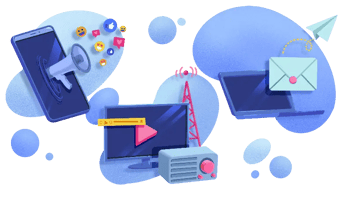Running a SWOT Analysis - How to Capture Threats
Our previous blog in this series explored how identifying external opportunities can propel your brand forward. But a truly comprehensive SWOT analysis doesn't stop there. It's a powerful tool precisely because it equips you to face not just sunshine and rainbows but potential storms as well. This is where understanding threats comes into play.
The "T" in SWOT Analysis
The "T" in the SWOT (Strengths, Weaknesses, Opportunities, and Threats) framework stands for threats. Threats represent the external factors lurking in the business environment that have the potential to disrupt your success. Picture them as hidden obstacles on the road to achieving your goals. Ignoring them can lead to costly
detours or even roadblocks.
Over 80% of business failures can be attributed, at least in part, to an inability to adapt to changing market conditions and unforeseen threats.
At its core, a threat is any external factor with the potential to impact your business negatively. This can encompass a wide range of elements, such as:
-
Economic Downturns: A recession or economic slowdown can lead to decreased consumer spending, impacting sales and profitability across various industries.
-
Technological Disruptions: Rapid technological advancement can render existing products or services obsolete, forcing businesses to adapt or risk falling behind competitors. Imagine the rise of ride-sharing apps disrupting the traditional taxi industry.
-
Changes in Government Regulations: New regulations or policy changes can impose compliance burdens, increase costs, or limit your ability to operate in certain markets.
-
Increased Competition: A surge in competition, either from established players or new entrants, can lead to price wars, market saturation, and difficulty securing market share.
-
Evolving Customer Preferences: Consumer tastes and demands are constantly changing. If your business fails to adapt to these shifts, it risks losing customer loyalty and market relevance. Consider the decline of brick-and-mortar stores due to the rise of e-commerce.
The potential consequences of ignoring threats can be significant. They can negatively impact various aspects of your business, including:
-
Sales & Profitability: Threats can directly impact your sales figures and profitability by reducing customer demand or increasing operational costs.
-
Brand Reputation: A poorly handled threat can damage your brand reputation, causing a loss of customer trust and loyalty.
-
Market Share: If your business fails to adapt to threats, competitors may exploit the situation and capture a larger market share.
-
Operational Ability: In some cases, threats can even threaten your ability to operate altogether. For example, new environmental regulations might force a manufacturing company to shut down production facilities that don't meet compliance standards.
The good news? By proactively identifying and addressing threats in your SWOT analysis, you can:
-
Mitigate Risks: By anticipating potential threats, you can develop strategies to lessen their impact on your business.
-
Strengthen Your Resilience: Proactive threat identification helps you build a more adaptable and resilient business capable of weathering unexpected challenges.
-
Gain a Competitive Advantage: Businesses that effectively address threats can emerge stronger and more prepared than their competitors, gaining a valuable edge in the marketplace.
By understanding threats' nature and potential impact, you can take proactive steps to address them within your SWOT analysis, safeguarding your business and paving the way for long-term success.
How to Identify Threats
Now that you understand the potential dangers lurking as threats, the next crucial step is identifying them within your SWOT analysis. This proactive approach hinges on a concept called environmental scanning. Essentially, it's the process of actively monitoring and analyzing external factors that could potentially impact your business. Think of it as keeping a watchful eye on the ever-changing weather patterns surrounding your business journey.
Here's a toolbox of techniques you can leverage for effective environmental scanning in the context of threat identification:
-
Industry Reports & Publications: Stay informed by subscribing to industry reports, publications, and trade journals. These resources offer valuable insights into current trends, potential disruptions, and emerging threats specific to your industry.
-
Competitor Analysis: Your competitors can be a valuable source of information. Analyze their strategies, product offerings, and marketing tactics. Are they venturing into new markets? Investing heavily in a particular technology? By understanding your competitor's moves, you can anticipate potential threats they might exploit.
-
Market Research: Conduct market research through surveys, focus groups, and social media listening to gain insights into evolving customer preferences and potential shifts in industry dynamics. Identifying early signs of changing consumer behavior can help you adapt before threats escalate.
-
Economic Forecasting: Stay abreast of economic forecasts and predictions. Understanding potential economic downturns or shifts in consumer spending power allows you to prepare for potential threats and develop contingency plans.
-
Social Media Listening: Social media platforms provide a goldmine of real-time customer sentiment. Listen to online conversations to identify potential concerns, complaints, or emerging trends that could morph into threats.
-
Industry Events & Conferences: Attending industry events and conferences allows you to network with peers, thought leaders, and experts. These interactions can provide valuable insights into your sector's potential threats and emerging trends.
-
Expert Consultations: Consider seeking advice from industry experts or consulting firms. Their specialized knowledge can offer a fresh perspective and help identify potential threats you might have overlooked.
Beyond Scanning: Cultivate a Proactive Mindset:
Environmental scanning is a powerful tool, but it's not enough to rely solely on reactive measures. Cultivate a culture of future thinking within your team. Encourage brainstorming sessions where you explore "what-if" scenarios and potential disruptions within your industry. This proactive approach allows you to anticipate threats before they materialize and develop strategies to mitigate their impact.
By combining environmental scanning techniques with a forward-thinking mindset, you can gain a comprehensive understanding of the potential threats lurking in your business environment. This paves the way for capturing them effectively within your SWOT analysis, allowing you to navigate the ever-evolving business landscape with confidence and strategic foresight.
Best Practices for Mitigating Threats
Identifying potential threats within your SWOT analysis isn't a one-time event. Here are some best practices to ensure you capture a comprehensive picture of the external threats your business faces:
Regular Threat Assessments
The business landscape is constantly evolving. Don't rely on a single SWOT analysis conducted months ago. Establish a schedule for regular threat assessments, perhaps quarterly or biannually. This allows you to stay up-to-date on emerging trends, changing regulations, and new competitive forces that could pose potential threats. Think of it as conducting regular weather checks to prepare for unexpected storms.
Don't Discount Seemingly Minor Threats
While some threats may seem insignificant initially, neglecting them can lead to bigger problems. For example, a minor shift in customer preferences might not seem alarming initially. However, if left unaddressed, it could snowball into a major threat to your market share. Develop a system for capturing even seemingly minor threats during your SWOT analysis. Small tweaks in customer behavior can be early warning signs of larger disruptions.
Prioritization is Key
Not all threats are created equal. Some pose a more significant risk to your business than others. Develop a prioritization system for the threats you identify in your SWOT analysis. Consider factors like:
-
Severity: How much damage could the threat potentially inflict on your business? Factors like potential loss of revenue, market share, or brand reputation can help assess severity.
-
Likelihood of Occurrence: How probable is it that the threat will materialize? Analyze industry trends, economic forecasts, and competitor actions to gauge the likelihood of potential threats becoming reality.
-
Impact on Your Business: How will the threat impact different aspects of your business? Consider potential impacts on sales, profitability, operations, or brand image.
Data-Driven Decisions
Don't base your threat identification solely on gut feelings or anecdotal evidence. Back up your findings with data and evidence from reliable sources. Utilize the information gathered through environmental scanning – industry reports, competitor analysis, and market research – to create a data-driven picture of your threat landscape. This adds credibility and weight to your SWOT analysis, allowing you to develop more effective mitigation strategies.
Capturing Threats: Do's and Don'ts
DO's:
-
Encourage Open Communication: Foster a culture of open communication within your team where everyone feels comfortable sharing potential threats they've identified.
-
Consider External Perspectives: Seek insights from external sources like industry experts, customers, and suppliers.
-
Develop Contingency Plans: Once you've identified threats, develop contingency plans to mitigate their impact or capitalize on potential opportunities that arise from them.
-
Stay Informed: Subscribe to industry publications, attend relevant conferences, and stay abreast of current events to remain informed about potential threats.
DON'Ts:
-
Ignore Early Warning Signs: Don't dismiss subtle hints of potential threats. Early action can significantly minimize negative consequences.
-
Underestimate the Power of Change: The business landscape is constantly evolving. Don't assume current threats are the only ones you'll face.
-
Panic Mode: Don't be paralyzed by fear when faced with threats. Instead, adopt a calm and analytical approach to develop effective mitigation strategies.
-
Ignore the Competition: Keep a close eye on the strategies of your competitors. Their response to threats can provide valuable insights and potential solutions.
Turning Threats into Opportunities for a Thriving Business
Understanding how to identify threats proactively is crucial for navigating the ever-evolving business landscape.
Key Takeaways:
-
Environmental Scanning is Key: Monitor external factors through industry reports, competitor analysis, and market research to uncover potential threats.
-
Embrace a Proactive Mindset: Cultivate a culture of "what-if" thinking within your team to anticipate future disruptions and threats.
-
Prioritization is Essential: Not all threats are created equal. Develop a system to prioritize threats based on their severity, likelihood of occurrence, and impact on your business.
-
Data-Driven Approach: Back up your threat identification with credible data and evidence from reliable sources.
By adopting a proactive approach to threat identification within your SWOT analysis, you unlock several benefits:
-
Cost Savings: Early identification allows you to develop mitigation strategies that minimize potential damage to your business, saving you time and resources.
-
Increased Resilience: Proactive threat management helps build a more resilient business that is adaptable to market changes and better equipped to weather unforeseen challenges.
-
Competitive Advantage: Addressing threats allows you to prepare your business for future uncertainties, potentially gaining an edge over competitors who fail to do so.
Take control of your business destiny! Conduct a comprehensive SWOT analysis and actively identify potential threats. By understanding these external challenges, you can develop strategic plans to mitigate their impact and ultimately transform them into opportunities for growth and success.
Need help? Aspiration Marketing consultants can guide you through the entire SWOT analysis process, from identifying threats to crafting effective marketing strategies.
Contact us today to learn more!
This content is also available in:
- Deutsch: Durchführen einer SWOT-Analyse - Erfassen von Bedrohungen
- Español: Realizar un análisis SWOT: cómo captar las amenazas
- Français: Effectuer une analyse SWOT - Comment saisir les menaces
- Italiano: Eseguire un'analisi SWOT - Come catturare le minacce
- Română: Efectuarea unei analize SWOT - Cum să identificați amenințările
- 简体中文: 进行 SWOT 分析--如何捕捉威胁










Leave a Comment